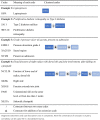ICD-11: an international classification of diseases for the twenty-first century
- PMID: 34753471
- PMCID: PMC8577172
- DOI: 10.1186/s12911-021-01534-6
ICD-11: an international classification of diseases for the twenty-first century
Abstract
Background: The International Classification of Diseases (ICD) has long been the main basis for comparability of statistics on causes of mortality and morbidity between places and over time. This paper provides an overview of the recently completed 11th revision of the ICD, focusing on the main innovations and their implications.
Main text: Changes in content reflect knowledge and perspectives on diseases and their causes that have emerged since ICD-10 was developed about 30 years ago. Changes in design and structure reflect the arrival of the networked digital era, for which ICD-11 has been prepared. ICD-11's information framework comprises a semantic knowledge base (the Foundation), a biomedical ontology linked to the Foundation and classifications derived from the Foundation. ICD-11 for Mortality and Morbidity Statistics (ICD-11-MMS) is the primary derived classification and the main successor to ICD-10. Innovations enabled by the new architecture include an online coding tool (replacing the index and providing additional functions), an application program interface to enable remote access to ICD-11 content and services, enhanced capability to capture and combine clinically relevant characteristics of cases and integrated support for multiple languages.
Conclusions: ICD-11 was adopted by the World Health Assembly in May 2019. Transition to implementation is in progress. ICD-11 can be accessed at icd.who.int.
Keywords: Classification; Epidemiology; Informatics; International classification of diseases; Statistics; eHealth.
© 2021. The Author(s).
Conflict of interest statement
JEH, SW, and CGC are or were members of several committees convened by the WHO to advise it on the 11th revision of the ICD. They received travel support—airline tickets and per diem payments to cover accommodation and other costs—from the WHO to allow attendance at some committee meetings. The total extent of this support for the three authors over about 11 years is estimated to be approximately USD 100,000, mostly for JEH and CGC. The group at Flinders University led by JEH received funds from the Australian Institute for Health and Welfare, which partly supported his contributions to revising the ICD. SW has been employed by the Institute of Medical Documentation and Information (DIMDI), a German government agency responsible for health classifications, including the ICD. She has represented DIMDI in committees and meetings concerning ICD and related matters. DIMDI was merged with the Federal Institute for Drugs and Medical Devices in May 2020. RJ is employed by the WHO. He has been the team leader of the group responsible for the ICD since 2015 and was a member of the team before that. CGC is faculty at Johns Hopkins and previously worked at Mayo Clinic. His work has been supported by multiple grants from the National Institutes of Health. University discretionary funds have supported his WHO work in part.
Figures



References
-
- Wood PH. Applications of the international classification of diseases. World Health Stat Q. 1990;43:263–268. - PubMed
-
- World Health Organization. World health statistics. 2020. http://www.who.int/gho/publications/world_health_statistics/en. Accessed 12 Nov 2020
-
- World Health Organization. History of the development of the ICD. http://www.who.int/classifications/icd/en/HistoryOfICD.pdf. Accessed 12 Nov 2020.
-
- World Health Organization. International Classification of Diseases (ICD). https://www.who.int/standards/classifications/classification-of-diseases. Accessed 27 May 2021.
-
- White A. Digital media and society: transforming economics, politics and social practices. New York: Palgrave Macmillan; 2014.
Publication types
MeSH terms
Grants and funding
LinkOut - more resources
Full Text Sources

